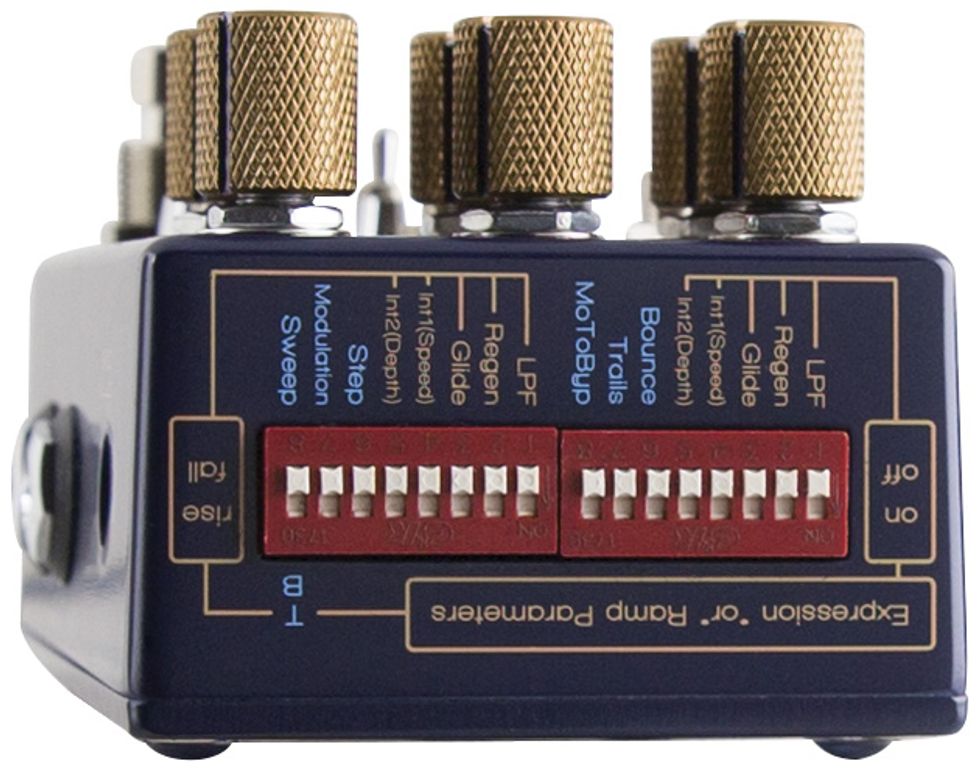RatingsPros:Boldly goes where no analog delay has gone before. Excels at retro echoes and modernistic glitches. Fine workmanship. Musically inspiring. Cons: Substantial learning curve. Noisy, lo-fi effects won’t appeal to some players. Street: $499 Chase Bliss Audio Thermae chaseblissaudio.com | Tones: Ease of Use: Build/Design: Value: |
Chase Bliss’ motto is “digital brain, analog heart,” and, man, does the shoe fit! Thermae, the latest creation by Joel Korte of Chase Bliss Audio, is an analog delay pedal like no other. Its heart is an old-school delay circuit with echoes provided by a pair of new-production MN3005 bucket-brigade delay chips. But unlike traditional or modern analog delays, the effect is manipulated by a set of flexible and comprehensive digital tools.
Thermae’s core “color” is ’70s-style delay, with the expected time, feedback, and mix controls, plus a treble-chopping low-pass filter. In general, the effect is dark toned and noisy as hell, but the vibe is unbeatable. Short, simple echoes are warmly musical. Longer echoes and high feedback settings devolve into analog chaos—often a complex and compelling slurry of no-fi echoes and escalating noise. The tones can be extremely pretty or pretty extreme, but by any traditional reckoning Thermae is a killer stompbox.
Controlled Chaos
You probably wouldn’t spend nearly $500 on a new-production analog delay that only did traditional tricks. That digital brain, however, is worth a lot. The Thermae control layout is similar to other Chase Bliss products—which is to say, pretty darn complicated: The front panel has six knobs, four 3-way switches, and two footswitches. And that’s just the start. Like the rest of the Chase product line, the front panel features a network of 16 tiny DIP switches that unlock additional functions and permit a vast range of control options when you hook up an expression pedal (not included).
Many of Thermae’s tastiest tricks involve pitch shifting. If you’ve ever spun an analog delay’s time knob while echoes are repeating (like David Byrne famously does in Talking Heads’ Stop Making Senseconcert film), you know bucket-brigade chips can spew treble screeches and subaqueous rumbles. We’re not talking relatively clean pitch shifts like you get from, say, a DigiTech Whammy pedal or Electro-Harmonix POG. It’s a noisy, smeary effect best suited to vicious noise bursts, and not something you’d ever expect to “control.”
You can, however, set specific delay intervals, creating echoes up to two octaves above or below the original pitch. You can also control the pitch-bend rate of the transpositions, from near-instantaneous to a lazy smudge. Further, one toggle lets you choose the modulating waveform (smooth sine wave, traditional triangle wave, or herky-jerky square wave), while another selects between straight-ahead modulation and two relatively glitchy and unpredictable modes.
Which Glitch Is Which?
Although Thermae offers up a tap-tempo footswitch that controls both delay time and modulation rate, the glitchy echoes can be tough to control rhythmically. But sometimes that’s the point—consider modern hip-hop and abstract pop, where deviations from the grid provide much of the vibe. Yeah, you can get roughly similar effects using simulated analog delay within a hardware- or software-based modeling environment. But as far as I know, no one else has pushed this antique analog-delay process to such modernistic extremes. The results can be eerie, liquid, and hauntingly beautiful.
Meanwhile, the self-deprecating Thermae manual may be the first documentation to feature the acronym TLDR (“too long, didn’t read”): Korte urges users to skip it and learn from a video by one of his collaborators, a popular effects and modular-synth demo artist on YouTube named Knobs. It’s good advice—check it out if you’re Thermae-curious.

Compulsive Behavior
Besides its basic sound-dialing options, Thermae also offers a host of performance-enhancing options. Holding the tap-tempo switch sustains the effect until delays devolve into runaway oscillation. A DIP switch lets you change the on/bypass footswitch to momentary mode. A tap-tempo jack lets you enter delay times with an external footswitch (not included), which can be handy in some pedalboard layouts.
Pressing both footswitches simultaneously cuts delay times (and pitch) by half. Another DIP switch determines whether delays stop the instant you press bypass, or spill over until they fully decay. And a 3-way memory toggle lets you recall two previously stored sounds (and their MIDI-controller routings), in addition to whatever the controls are currently set to. Nice!
The pedal is beautifully made, with classy metal knobs and quality jacks and switches. Inside, it’s … dense. Delays are usually the most parts-intensive analog effects, and here there’s all that controlling/switching stuff, too. There’s no room for a battery, but that’s fine, since this circuit would gulp down its power in record time anyway. Thermae runs on standard 9-volt power supply, but you need at least 180ma of current.
The Verdict
If you like your effects clean and pristine, you may want to avoid Chase Bliss Audio’s Thermae. However, if you tend to find beauty in noise, imperfection, and randomness, chances are you’ll be spellbound by it. (Given the sheer number of controls, it’ll help if you’re happy spending time tweaking options, too.) Thermae’s traditional bucket-brigade delay tones are splendid, while clever functionality adds welcome 21st-century twists. The price is formidable, but it’s reasonable given the superb workmanship, high parts count, and the endless hours of R&D this pedal surely required. Thermae is a creative and ambitious effect for creative, ambitious players.









![Rig Rundown: Russian Circles’ Mike Sullivan [2025]](https://www.premierguitar.com/media-library/youtube.jpg?id=62303631&width=1245&height=700&quality=70&coordinates=0%2C0%2C0%2C0)

















